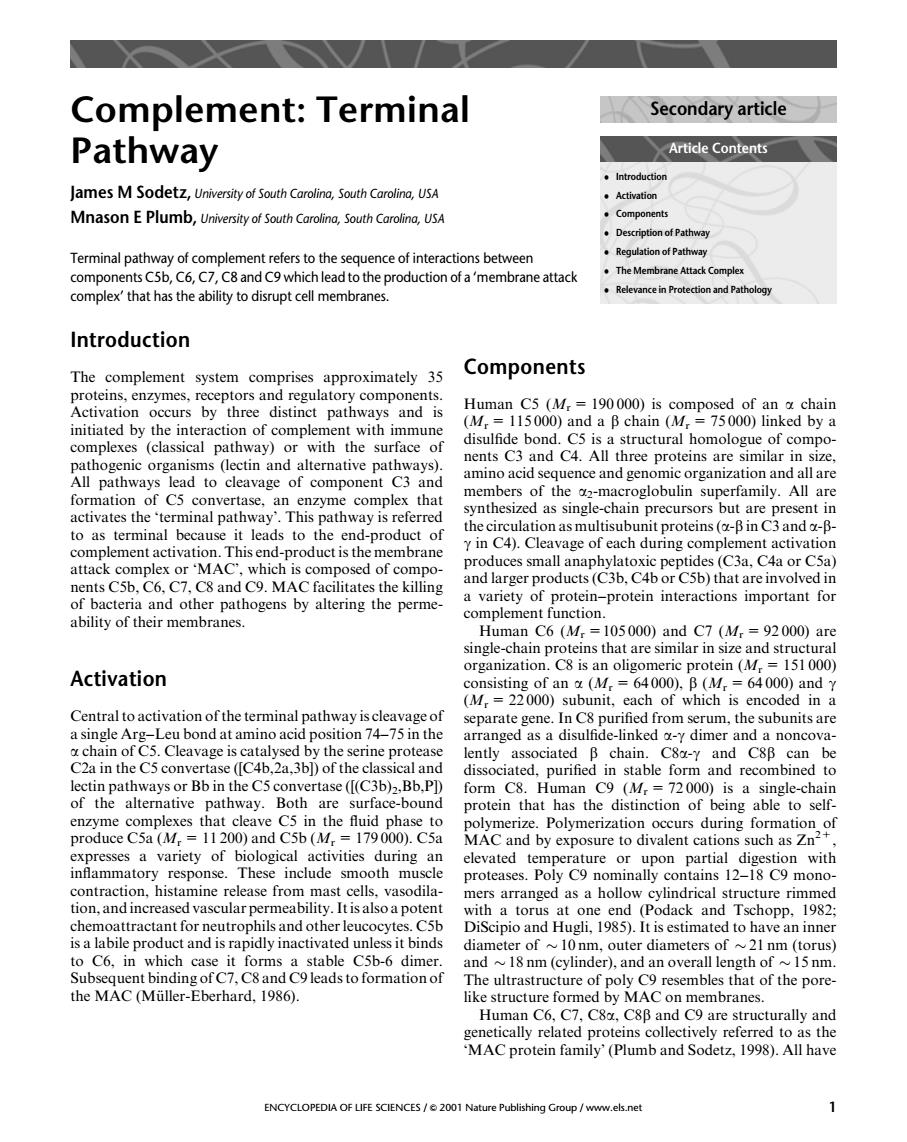正在加载图片...

Complement:Terminal Secondary article Pathway Artice Contents ames M odetz,University of South Carolina,South Carolina,USA Mnason E Plumb,University of South Carolina,South Carolino,USA Terminal pathway of complement refers to the sequence of interactions between The Membrane Attack Comple components C5b,C6,C7,C8 and C9 which lead to the production of a'membrane attack complex'that has the ability to disrupt cell membranes. .Relevance in Protection and Patholog Introduction The complement system comprises approximately 35 Components proteins,enzymes,receptors and regulatory components Activat e m da B chain (M patho enic organisms (ectin and alternative pathways) All pathways lead to cleavage of component C3 and amino acid sequence and genomic organization and all are formation of C5 ain precursors ay is re e present in complement actiation.Thisend-productis themem in C4)Cleavag e of each during c ent activa attack complex or 'MAC,which is composed of compo- nents Csb,C6.C7.C8and C9.MACf the killing biactsrund hogens by altering the perme- a variety of protein-protein interactions important for C6M,=105000andC7(M.=92000ar single-chain proteins that are simiar in size and structural organization.C8 is a 151000 Activation Central to activation of the terminal pathway is cleavage of eparate gene.In C8 purified from se ichicancoieind arranged as a disulfide-linked a-y dimer and a noncova he se proteas ently C8u-Y and C8B can be vertase(f(C3b)2.Bb.Pl) 0=720 infammatory response.These levated on with contraction,histamine release from mast cells,vasodila- e rimmed with a torus at one end (Podack and Tschopp,1982; che sand other DiScipio and Hugli,1985).It is estimated to have an inner to C6.in which case it for s a stable C5b-6 dimer nm.outer dameters Subsequent bindingof C7,C8and C9leads to formationof The ultrastructure of y C9 resembles that of the pore- the MAC(Miiller-Eberhard,1986). like structure formed by MACon embrancs. C8.C8B and C9 are structurally and pro ns prot ENCYCLOPEDIA OF LIFE SCIENCES/2001Na hing Group/www.els.netComplement: Terminal Pathway James M Sodetz, University of South Carolina, South Carolina, USA Mnason E Plumb, University of South Carolina, South Carolina, USA Terminal pathway of complement refers to the sequence of interactions between components C5b, C6, C7, C8 and C9 which lead to the production of a ‘membrane attack complex’ that has the ability to disrupt cell membranes. Introduction The complement system comprises approximately 35 proteins, enzymes, receptors and regulatory components. Activation occurs by three distinct pathways and is initiated by the interaction of complement with immune complexes (classical pathway) or with the surface of pathogenic organisms (lectin and alternative pathways). All pathways lead to cleavage of component C3 and formation of C5 convertase, an enzyme complex that activates the ‘terminal pathway’. This pathway is referred to as terminal because it leads to the end-product of complement activation. This end-product is the membrane attack complex or ‘MAC’, which is composed of components C5b, C6, C7, C8 and C9. MAC facilitates the killing of bacteria and other pathogens by altering the permeability of their membranes. Activation Central to activation of the terminal pathway is cleavage of a single Arg–Leu bond at amino acid position 74–75 in the a chain of C5. Cleavage is catalysed by the serine protease C2a in the C5 convertase ([C4b,2a,3b]) of the classical and lectin pathways or Bb in the C5 convertase ([(C3b)2,Bb,P]) of the alternative pathway. Both are surface-bound enzyme complexes that cleave C5 in the fluid phase to produce C5a (Mr= 11 200) and C5b (Mr= 179 000). C5a expresses a variety of biological activities during an inflammatory response. These include smooth muscle contraction, histamine release from mast cells, vasodilation, and increased vascular permeability. It is also a potent chemoattractant for neutrophils and other leucocytes. C5b is a labile product and is rapidly inactivated unless it binds to C6, in which case it forms a stable C5b-6 dimer. Subsequent binding of C7, C8 and C9 leads to formation of the MAC(Mu¨ller-Eberhard, 1986). Components Human C5 (Mr= 190 000) is composed of an a chain (Mr= 115 000) and a b chain (Mr= 75 000) linked by a disulfide bond. C5 is a structural homologue of components C3 and C4. All three proteins are similar in size, amino acid sequence and genomic organization and all are members of the a2-macroglobulin superfamily. All are synthesized as single-chain precursors but are present in the circulation as multisubunit proteins (a-b in C3 and a-bg in C4). Cleavage of each during complement activation produces small anaphylatoxic peptides (C3a, C4a or C5a) and larger products (C3b, C4b or C5b) that are involved in a variety of protein–protein interactions important for complement function. Human C6 (Mr=105 000) and C7 (Mr= 92 000) are single-chain proteins that are similar in size and structural organization. C8 is an oligomeric protein (Mr= 151 000) consisting of an a (Mr= 64 000), b (Mr= 64 000) and g (Mr= 22 000) subunit, each of which is encoded in a separate gene. In C8 purified from serum, the subunits are arranged as a disulfide-linked a-g dimer and a noncovalently associated b chain. C8a-g and C8b can be dissociated, purified in stable form and recombined to form C8. Human C9 (Mr= 72 000) is a single-chain protein that has the distinction of being able to selfpolymerize. Polymerization occurs during formation of MACand by exposure to divalent cations such as Zn2+, elevated temperature or upon partial digestion with proteases. Poly C9 nominally contains 12–18 C9 monomers arranged as a hollow cylindrical structure rimmed with a torus at one end (Podack and Tschopp, 1982; DiScipio and Hugli, 1985). It is estimated to have an inner diameter of 10 nm, outer diameters of 21 nm (torus) and 18 nm (cylinder), and an overall length of 15 nm. The ultrastructure of poly C9 resembles that of the porelike structure formed by MACon membranes. Human C6, C7, C8a,C8b and C9 are structurally and genetically related proteins collectively referred to as the ‘MACprotein family’ (Plumb and Sodetz, 1998). All have Article Contents Secondary article . Introduction . Activation . Components . Description of Pathway . Regulation of Pathway . The Membrane Attack Complex . Relevance in Protection and Pathology ENCYCLOPEDIA OF LIFE SCIENCES / & 2001 Nature Publishing Group / www.els.net 1